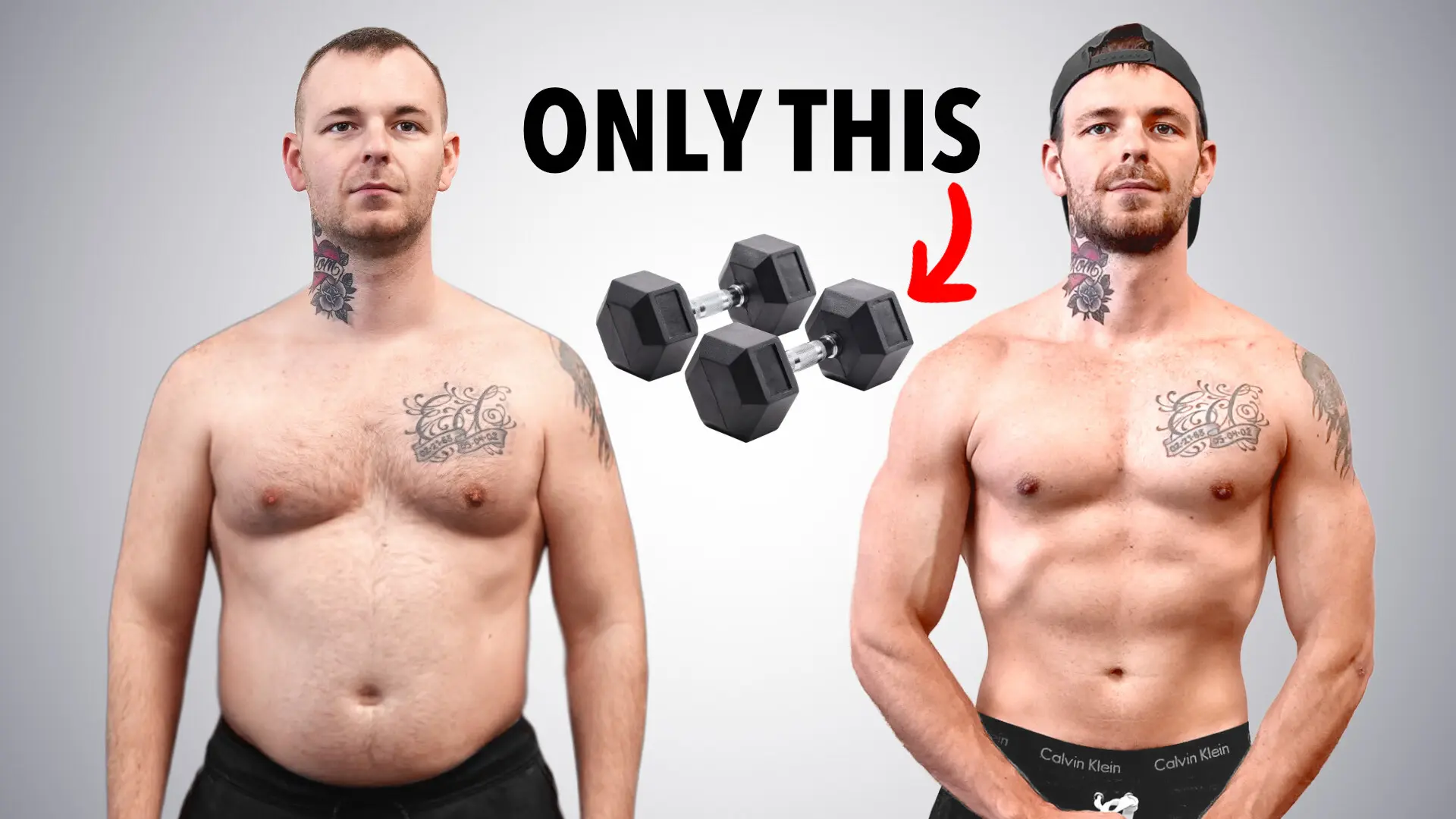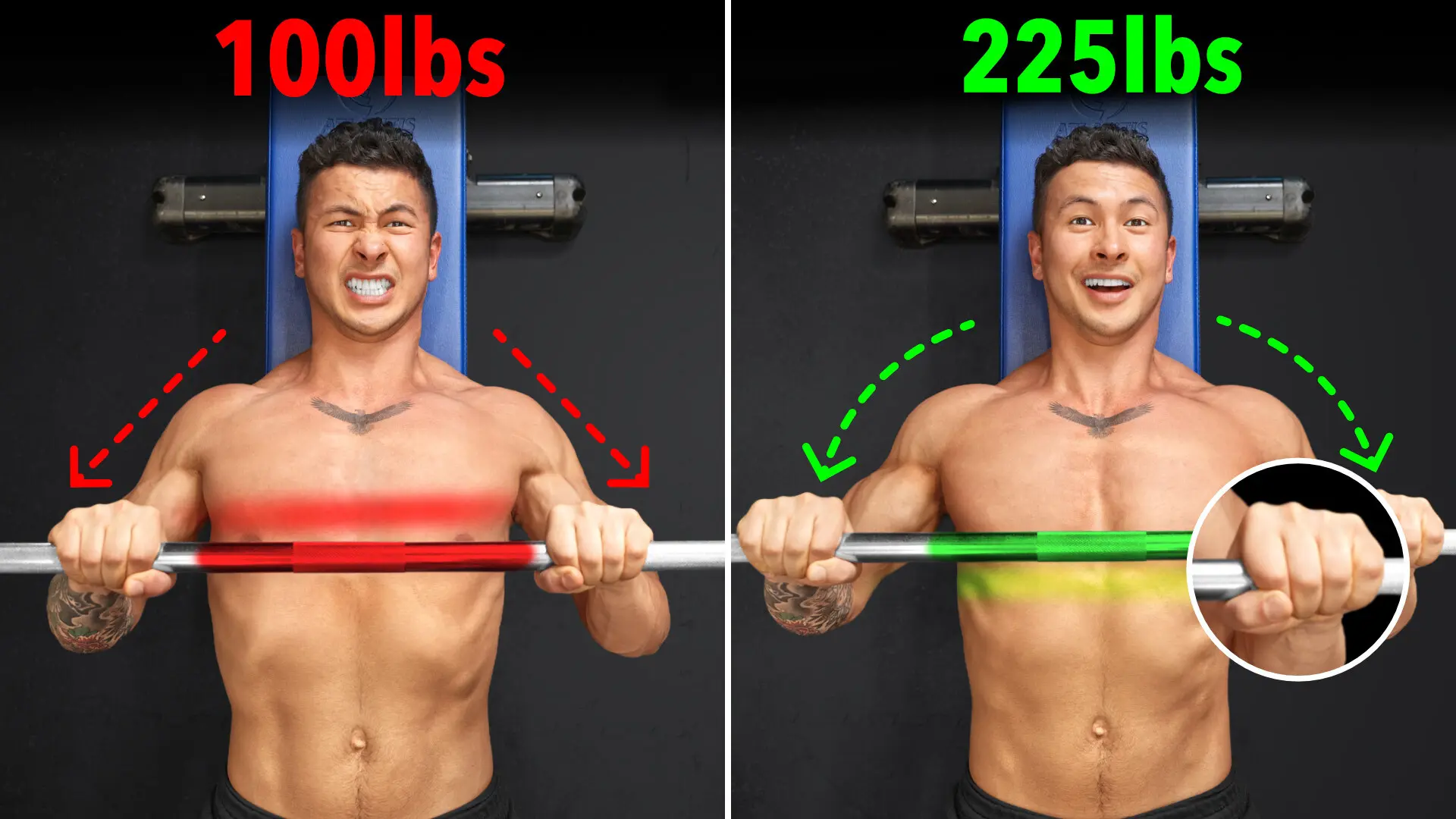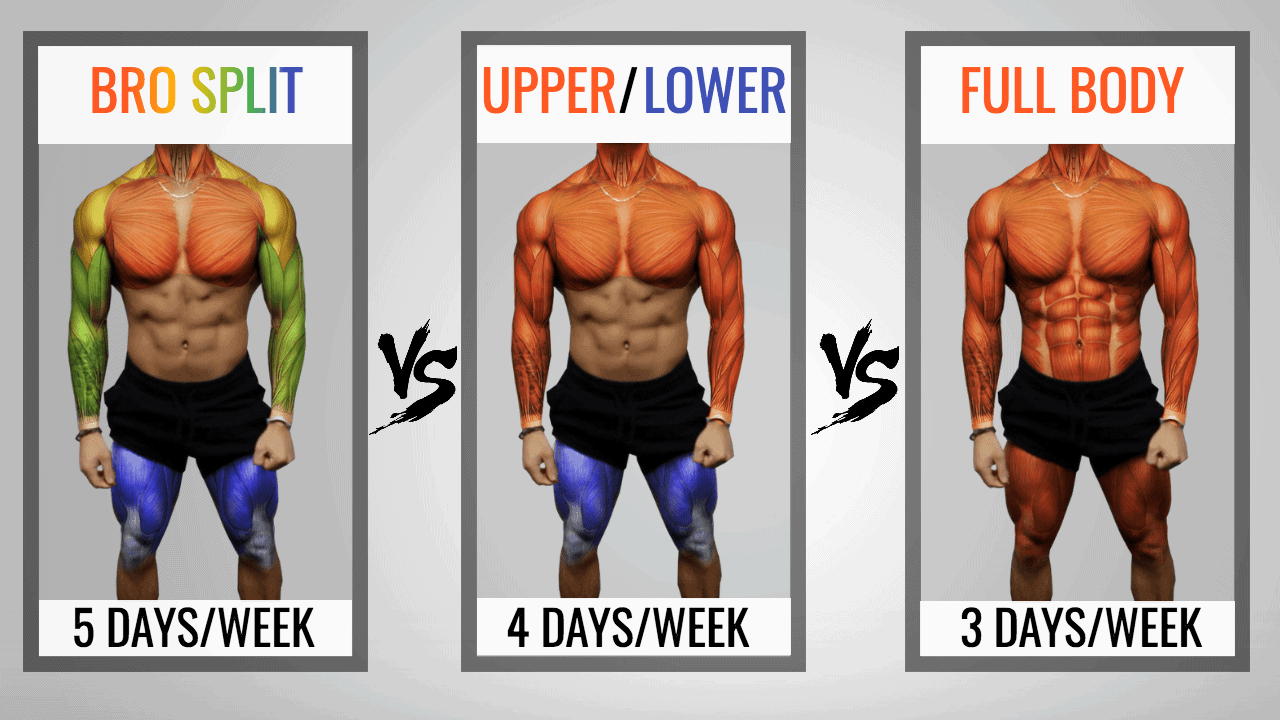
Best Upper Lower Split Workout Routines
What are workout splits?
As its name suggests, a workout split describes how you’d “split up” your training sessions throughout the week to focus on different muscle groups or movements.
Beyond simply giving structure to your workout routine (i.e., telling you what you should be working on any day), “dividing up” your training sessions also increases the chances that you’re:
- Giving your muscles adequate time to recover, repair, and rebuild between sessions, and
- Hitting each muscle group with enough volume to grow optimally
That said, not all workout splits are made equal. Certain workout splits will be better suited to you than others depending on your lifting experience, how often you can or are willing to train, and your personal preferences.
And as for how you could know which workout split(s) fits you, that’s what the rest of this article is for.
What is the best split for working out?
Should you do the bro split and work out 5 days a week? Should you split up your routine into upper and lower body and work out 4 days a week? Alternatively, should you do a full body workout 3 days a week? In this article I will cover the advantages of each of these workout splits and the downsides as well…
One of the biggest decisions you have to make when starting out in the gym is choosing what workout split (or “workout schedule”) you’re going to use. Or in other words, simply figuring out how you’re going to schedule your exercises throughout the week.
For example, when I first started going to the gym, I used what was popularized in fitness magazines and what everyone at the gym seemed to be doing; the bro-split. At the time, the so called “bro-split” seemed to be used by everyone.
Before that: if you're looking for a training program that'll help you set up every single one of your workouts for optimal muscle growth (so you never have to worry about a specific 'split'), I've got just the thing for you. Every BWS program is designed to be an all-in-one, science-based process that’ll get you to your dream physique FAST. And best of all? It's all rooted in science. For more information:
Click the button below to take my analysis quiz to discover the best program for you:
↓
Upper Lower Workout Split Schedule
This workout routine is very simple in that it involves training each muscle group once per week. The volumes in each workout are very high as the muscle has about a whole week to recover until the next time it is trained.
Very few people seemed to be against this workout split. Therefore, it was the easiest thing to take up. I could base my workouts on others as there was adequate information available.
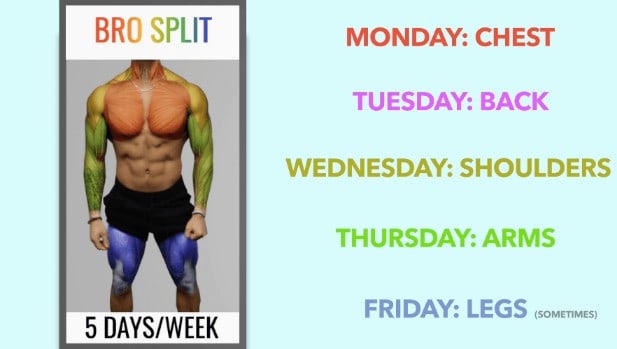
The above picture shows an example of the details of the bro-split workout. Each weekday would be dedicated to one muscle group. My upper lower split schedule went something like this: I’d workout my chest on Monday, the back muscles worked out on Tuesday, the shoulders worked out on Wednesday, the arms worked out on Thursday, and Fridays were reserved for everyone’s favorite… the legs. Weekends would be used to rest and recuperate until the next week.
The photo shown below of me (at 18 or 19 years old) demonstrates the results of the bro-workout routine after a few years of this style of training. As you can see in this photo, I definitely made good progress:

But looking back with the knowledge I now have, it begs the question as to whether or not I would have progressed noticeably faster had I used a different or “better” workout schedule than the bro-split. And honestly, I think there’s a good chance I would have.
Of course, there are many other things that contribute to your progress in the gym and these have been covered extensively in my videos.
But staying on the topic of workouts. I would have done things a little differently and recommend you do as well, let’s begin by first taking a look at our options.
The upper/lower split
One popular option is to train certain groups of muscles together during each science-based workout.
An example of this is the upper/lower split, which is a 4 day workout split. Essentially, the upper body is trained on one day and the lower body on the next. This is followed by a day off. The same two day routine is then repeated.
In this split, the workouts are divided among the same time period. That is to say, going through the split twice still spans 5 days when you include the rest day in between.
The weekends can be used to rest and recuperate as seen before. Its tempting to take less breaks, for example one day on the weekend instead of two. But keep in mind that rest is just as, if not more important then exercise.
Rest is key
Your body absolutely needs those days off to rebuild your muscles and prepare for the next workout. Not giving the body sufficient time to do this is guaranteed to result in decreased performance and overall results.
How to divide workout days?
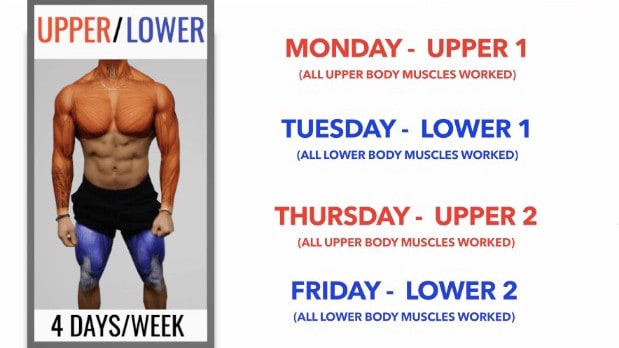
The above picture shows an example of the upper/lower workout split. Basically, the upper body is worked out on Monday and Thursday. The lower body is worked out on Tuesday and Friday. Wednesday is the rest day between the two cycles which means they span 5 days altogether. The weekends are also reserved for rest and recuperation.
Push/pull/legs split
Similar to the upper/lower split is the concept of push/pull/legs split. This routine is slightly longer as since it spans 6 days. Similar to the upper/lower split, the push/pull/legs routine trains multiple muscles are trained together during each day.
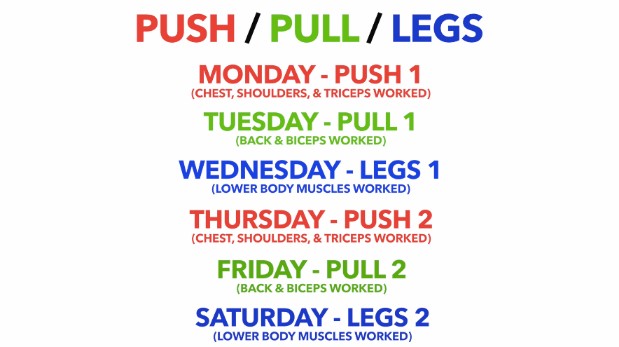
A sample of the push/pull/legs workout is shown above. The push days are Mondays and Thursdays. On these days, the chest, shoulders, and triceps are exercised. These workout involve “pushing” movements. Tuesdays and Fridays are reserved for “pull” type workouts and focus on the back and biceps exercises. Wednesdays and Saturdays are days on which the lower body is the focus. Sundays are for rest and recuperation.
The Full body workout
Another popular option, which is basically the opposite of the bro-split, is a full body workout routine that is most commonly done as a 3 day workout split.
While the workouts require only three days, each will involve substantial time and effort as a large number of muscle groups will be stressed on each of these days. The days in between the workouts are reserved for rest as are the weekends.
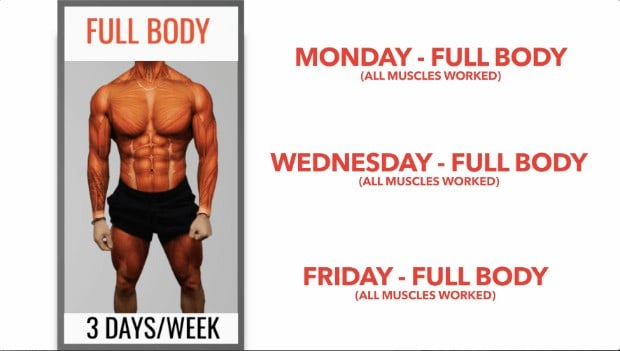
The picture above shows the full body workout split which involves 3 days of training. These training days are Mondays, Wednesdays, and Fridays. On these days, all the major muscles groups are worked out.
It would take substantially longer to train muscle individually. With the total body workout split, you train all of your muscles during each workout mainly through the use of compound exercises.
This has multiple advantages in that it requires less time as it trains multiple muscles simultaneously. It also allows you to recruit multiple muscles to perform complex movements to improve coordination and body control.
Why the Bro-Split is Inferior
The workout splits just discussed are likely superior to the bro-split for a variety of reasons. The next section of this article will discuss these reasons and layout why you will likely want to utilize one of these routines instead of the bro split.
We will also talk about some advantages of each of these split to help you decide which best fits your needs.
The main advantage of these splits over the bro split has to do with muscle training frequency.
Let’s take some time to look at the evidence that is presented in the literature:
Because as outlined in this 2016 meta-analysis by Schoenfeld and colleagues, when volume is matched:
Training each muscle at least 2x/week results in significantly greater muscle growth than training each muscle just once per week as you do in a bro-split.
In fact, as stated in a further meta-analysis by Greg Nuckols:
Subjects training at a higher frequency grew on average 38% faster than those training at a lower frequency.
This finding is illustrated in the graph below: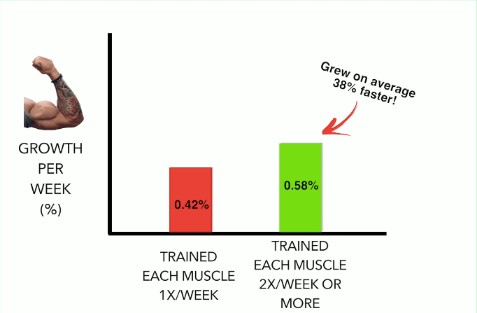
And a similar results were found for upper body strength gains as well.
Let summarize the main drawback of the bro split. The bro split focuses on one muscle group on each day of the week. Training muscles more than once a week can cause significantly greater hypertrophy as proven by the above articles.
Frequency of upper lower split workouts
Lower frequency
Using lower frequency that trains each muscle group 1-2 times per week has some advantages. First, you are able to perform greater volume of work per muscle group in each session. This is in part because you have greater time between workouts of each muscle group and therefore greater recovery time.
The downside is that you will not be able to add as much volume, since the workouts will end up being longer that most people are willing to spend.
This brings us to the alternative and possibly complimentary method…
Higher frequency
What about using higher frequency – by training each muscle group 2 – 4 times a week…
Well, this also has some advantages too. The consensus is that this gives you better muscle synthesis over time and thus greater increases in strength. It also allows you to increase your volume to a greater extent but dividing the time you spend on a muscle group over multiple workouts. The sum of each of these sessions will be greater and so the total volume will be more.
Training each muscle at least 2 times a week seems to be correlated with greater muscle growth as show by this study.
The downside of higher frequency, is that you will have to workout more often, 4 – 6 times per week. As a by-product, you will likely feel more fatigued and get a lesser pump during each session. Despite this, each session itself will be shorter in duration which may be desired.
Less is more...
But more is not necessarily better. In fact, this study has shown that training each muscle 2 times a week is better for muscle growth than training 4 times a week.
The reason behind this is likely to be muscle protein synthesis, which is elevated above baseline levels in the first 36 – 48 hours after a workout as shown by this study. So, your body repairs its damaged muscle tissue in the first 2 days after a workout…. You should avoid training the same muscle group within this time period.
In short, training each muscle group too frequently may interfere with recovery. So, as has been established for some time… rest is just important as the workout.
In fact, training with high volumes will certainly lead to the greatest gains in the short term but will not be sustainable in the long run.
What about within each session?
In general, the muscles which you focus on initially will be better activated. Evidence shows that you should focus on the muscle which are most important to you at the start of the workout. This leaves those that you want to focus on less to near the end.
To maximize muscle hypertrophy, you will want to aim for sets of 6 – 8 reps. If the weight you are using is too light, you will be able to perform more and if it is too heavy you wont be able to perform quite enough reps.
Frequency is key
The reason for the above finding and the main disadvantages of the bro split is likely due to two factors:
- Higher training frequencies are likely better able to optimize the protein synthesis response throughout the week.
- Higher training frequencies enable you to perform higher quality sets.
Let’s spend some time discussing what is meant by “higher quality sets”?
Well, for example, let’s say you do 16 sets of chest per week with 4 exercises using a bro-split. During this workout you would start to fatigue after your first exercise, causing your performance and resulting work output to decrease from then on.
The quality of your sets would decrease with each set that you perform.
Whereas if you were to split that into two workouts per week, for example as part of your push days, then you’d be able to perform those exercises with better quality:
Whereas if you were to split that into two workouts per week, for example as part of your push days, then you’d be able to perform those exercises with better quality:
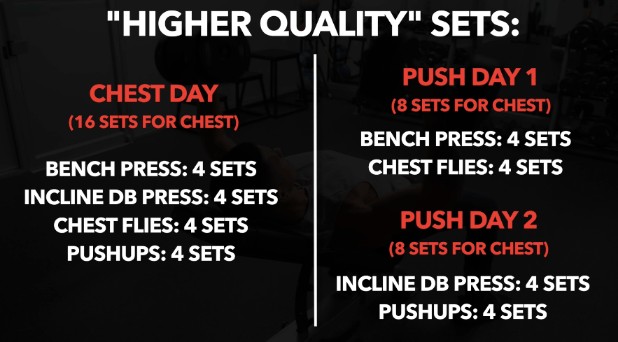
The figure above shows on the left the chest day workout that would be performed on one day of the bro split workout routine. This includes 4 sets of each of 4 different chest exercises for a total of 16 sets.
The alternative, which allows training of the same muscle on multiple days to increase frequency and set quality is presented on the right. The push-pull-legs split is shown here. The two push days, each include 4 sets of 2 workouts to focus on the chest. By splitting the workout in this way, the same 4 exercises can be performed for higher quality sets.
In addition…
Volume makes all the difference
You would also be likely achieving a greater work output (sets x reps x load) since you’re not doing as much volume all in the same day and can thus exert more effort during each set that you perform.
And hence, you can see how the bro-split may not be the best option. The reasons shown above indicate that opting for a training split which instead works each muscle at least twice per week is likely closer to optimal:
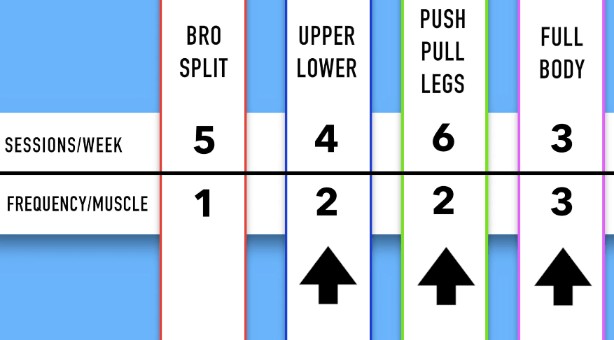
The above figure shows the 4 discussed workout routines: the bro split, the upper-lower split, the push-pull-legs split, and the full body workout. The sessions required per week for each of these routines is listed, with the full body being the least and the push-pull-legs being the most. The frequency of working each muscle group is also shown. The bro-split works out each muscle only once a week. The full body workout works each muscle group three times per week; once in each session.
Higher frequency workout splits
We talked above about the advantage of increasing training frequency…
So, which of these “higher training frequency” splits is best for you? This will depend on a variety of factors including, most importantly your training experience.
The Best Workout Split for Beginners
Mind to muscle connection
Beginners should keep their workouts simple. This means that they should focus on increasing repetition volume but avoid altering the number of sets they perform.
The program should be limited and a few movements should be used and in order to develop foundational motor patterns. By repeating the same movement, using the same movement allow you to establish neural patterns more quickly.
These basic neural patterns can then be used to develop your mind to muscle connection.
If you’re a beginner and just getting started in the gym, then I’d recommend the full body workout split two to three times per week.
The full body workout split mainly utilizes compound exercises to hit multiple muscles within each workout routine.
As a beginner, your primary goals should be to:
- Improve your motor coordination. Performing compound movements is key to mastering them. The initial period of time will allow you to increase your knowledge of the gym and correspond to a fast learning curve.
- Build up a base level of strength and endurance. Your strength and endurance capabilities will initially increase very quickly. This formative period is an ideal time to focus on areas to create a well-rounded set of capabilities. With time, changes will become more gradual.
- Avoid causing excessive muscle damage. Tissue damage and subsequent repair is a good way to build up muscle mass. However, it requires greater recovery times and more diligent diet, rest, etc. Therefore, in the initial stages when hypertrophy will come naturally, excessive damage is not necessary to see improvements.
A full body training split enables you to perform compound movements more frequently when compared to other splits. You will be able to train each muscle group three times per week. This more frequent training will allow you to master them more effectively and build a solid base of strength faster than you would otherwise.
In fact, this 2018 paper by Ochi and colleagues found that training each muscle 3x/week as you do in a full body split, is not only more effective at improving strength in untrained individuals when compared to lower training frequencies...
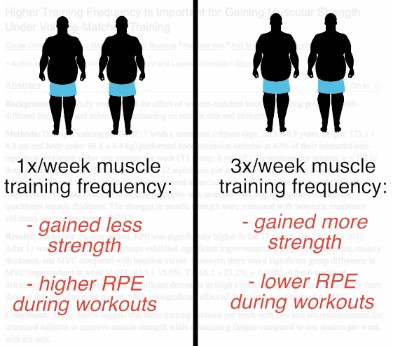
The figure above shows on the left that training each muscle once a week results in lesser gains in strength and higher perceived level of exertion. On the right, training muscles three times a week corresponds to greater increases in muscle strength and lower perceived exertion during each workout.
…but it also reduced their rate of perceived exertion.
Meaning that they felt their workouts were easier and they were able to recover faster, despite actually performing the same amount of volume as the lower frequency group. Which is a major bonus as a beginner since you’re more prone to muscle damage, fatigue, and soreness from your workouts.
level of training is a key determinant
Therefore, we can summarize by saying that muscle groups should be activated closer to three times a week and through a full body workout split. This breakdown is likely to be closer to ideal for beginners to maximally benefit and gain familiarity with the gym.
Full body workouts do have the downside of being longer in duration. Even though they are performed only 3 days a week, this time constraint may become less than ideal. This leads us to the next level of gym competency.
Really enjoy digging into the research on optimal workout splits? Then you'll absolutely love working with my team of highly-qualified trainers and nutritionists (plus myself!); in the process of guiding you through the process of achieving your dream physique in the time-efficient way possible, we'll also make sure you understand the science behind it all. Find out more here:
Click the button below to find out more about the 3-on-1 coaching program:
↓
The Best Workout Split for Intermediate/Advanced Lifters
Despite the various benefits of full body workouts, given the positive relationship between volume and muscle growth, as you gain more experience you’re inevitably going to have to increase volume in order to further progress at the optimal rate.
And although you could simply continue increasing the volume of your full body workouts…
There will come a point where your workouts just become too long and fatiguing to complete.
And in fact, based on research in rats at least, there may be an upper limit to the number of sets you can do per muscle in a single workout before its benefit on muscle protein synthesis plateaus:
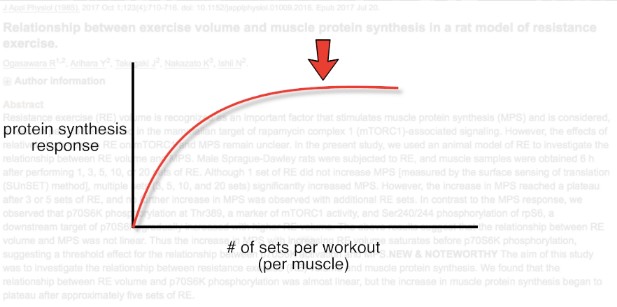
Since this research was not carried out on human subjects, the exact number at which benefits do not increase is not clear, but it does imply that:
Once we go above a certain threshold of workout volume, splitting it into separate workouts throughout the week should produce greater muscle growth than performing it all in a single workout.
Hence why I’d recommend that once your progress stalls with the full body split, switch to a 4 day workout split like the upper/lower split or something similar such that you have more training days to fit in extra volume.
The upper-lower split will allow you to train muscle groups multiple times a week and essentially divide the volume up amongst several days (depending on the split).
5 and 6 day splits
With the progression of time and as you gain even more experience, it may be wise and possibly more enjoyable for you to switch to a 5 day workout routine or a 6 day push/pull/legs split or something similar:
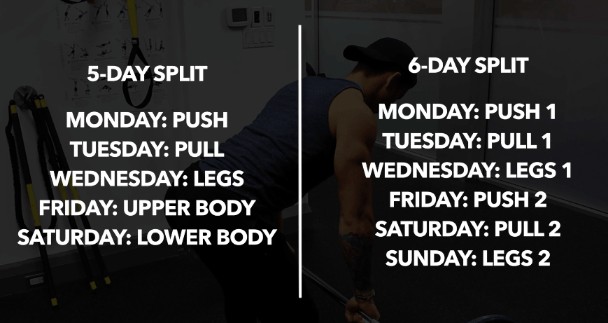
On the left, an example of the 5 day split is shown. This variation on the push-pull-legs allows you to focus on each of these on successive days. Thursdays would be a rest day for recovery and the next two days would be used to train the upper and lower body, each on separate days.
As the desire for greater workout volume increases, a 6 days split can be used that alternates push-pull-legs on each days with Thursday again used for rest. Of course, the workout could be started on any other day as well (not necessarily Monday).
The 6 day split will once again enable you to fit in extra volume as needed to continue progressing without causing your workouts to be excessively long.
Keeping in mind that there is little evidence for training muscle groups mores than 3 times a week. And that training one day a week does not allow one to attain the necessary volume which most practiced lifters require. The 6 days split may be right in the sweet spot of training frequency.
How much volume is enough volume?
Sets per muscle per week is key!
The good news is that even 1 – 4 sets per weeks seems to have beneficial results. Those who can only train once a week because of time or age constraints will still see results.
However, as discussed in my previous video about 10 - 20 sets a week is what you should be aiming for.
In fact, the difference between 1-4 sets per week vs. 10 sets per week for a muscle group is double the amount of hypertrophy as shown here.
Keep in mind, that too much volume is also not good. As discussed earlier, training more is not always great as it sacrifices rest and recuperation.
Total weekly volume and long-term adherence to your training program are ultimately the best indicators of success in your training routine.
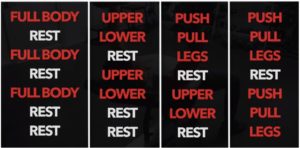
The image above shows 4 good alternatives, all of which allow for 2 – 3 times training of each muscle group. These are included in training splits that use 3, 4, 5, and 6 days of training from left to right.
Indirect sets
Some muscles such as those in the arms, as well as the traps and delts get a lot of indirect training as they are activated in multiple workouts focusing on other muscle groups.
To avoid over training these muscles, and allow enough time for rest, these should be directly trained with less volume unless you are trying to prioritize these groups.
Periodization
Training at different frequency week in and week out is recommended by many experts as a way to optimal gains.
Keep in mind that beginners should absolutely not periodize their workouts. In fact they should keep a simple routine that focuses on establishing a mind to muscle connection and use lower volumes (about 10 sets per muscle per week).

The figure shown above breaks down what might be a transition from low to moderate to high volume training of muscle with an increase in frequency every two weeks.
The volumes fall within the range of 10 – 20 sets for each muscle each week which seems to be within the optimal range for muscle growth. This range of sets can also be accommodated in the 2 – 3 sessions of training per week as this seems to be ideal.
For example, at the lower end, training each muscle 2 times a week and using 3 sets on each occasion (with two different exercises) could be recommended.
At the higher end, training each muscle group 3 times a week and using 4 – 5 exercises with about 5 sets of each could be used to achieve the prescribed 20 set total.
Variation has many benefits
The following study shows that those who changed from training each muscle group 2 times a week to once a week increased their muscle growth over 10 weeks compared to those who stayed with their 2 times a week routine.
For well trained lifters at least… It seems that changing the frequency of exercise every once in a while, may lead to greater muscular growth and keep things interesting in the long run.
Consistency is key
Just know that workout volume and consistency are the most important factors, so focus on those two variables and you will see positive results regardless of the split you use.
What ever split you end selecting, it is important to stick with it for an extended period of time. Only then will you be able to see results and assess the success of a routine.
Summary
But as you can see, although some routines have various advantages over others, there really isn’t one “best workout split”. In fact, it is likely that no routine is perfect for anyone but one may be better than the rest for you. As you become more familiar with your body you can better decide how to divide your workout for best results.
In addition to everything else that is important, your training routine should simply be viewed as a tool to organize your workout volume in a way that is most enjoyable and practical for you.
Frequency
I started with a bro-split which may be practical for some. In fact about 70% of professional body builders train muscle groups only once a week according to this study. So, training each muscle once a week certainly does work, but how well does it work?
In contrast, training 2 – 3 times a week increases muscle hypertrophy to a greater extent than training once a week as shown by the following survey of multiple studies.
Splits
The full body workout split seems to be a good starting split and can be used by those requiring lesser volumes. The push-pull-legs or the upper-lower body splits allow for greater volumes to be used in a manageable way but dividing them over multiple days.
You may also settle on something that has some of the advantages of each of these split or, something completely different. Ultimately, through trial and error you will be able to find what is best for your training needs.
For more content
…And if you’re looking for a step-by-step program that shows you how to optimize both your training AND nutrition in order to progress as efficiently as possible… Then simply take my starting-point analysis tool here to find which program is best for you:
Click the button below to take my analysis quiz to discover the best program for you:
↓
That’s it for this article – hope you enjoyed it and found it useful! Don’t forget to give me a follow and connect with me on Instagram, Facebook, and Youtube as well. Cheers!


